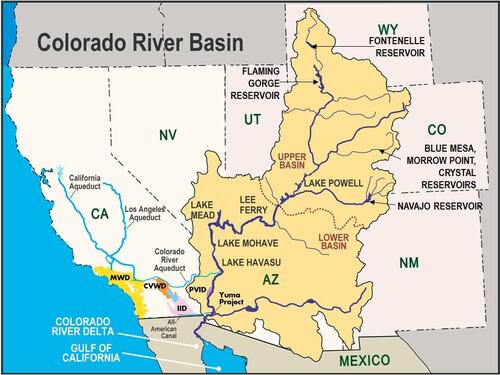Feds Cut Water Deliveries To Arizona And Nevada, May Impact Food Production
Arizona and Nevada face deeper cuts on the amount of water they can draw from the drought-stricken Colorado River, the Interior Department’s Bureau of Reclamation said Tuesday.
The agency responsible for managing water and power in the western US said “urgent action” is needed as water levels in the Colorado River’s two largest reservoirs — Lake Mead and Lake Powell — continue to drop. Under the new conservation efforts, 21% of Arizona’s annual water allocation from the river system will be reduced in 2023.
Nevada will see 8% of water deliveries reduced, and Mexico’s share will be cut by 7%. California will be spared from the new measures that begin next year.
The reductions could be the beginning of a water crisis for the 40 million Americans in seven states (Colorado, New Mexico, Utah, Wyoming, Arizona, California, and Nevada) that heavily rely on the river for freshwater and power.
The move comes as the western US faces the worst megadrought in 1,200 years that has decreased levels in Lake Mead, the largest reservoir in the US, to lows not seen in eight decades.
Lake Powell, meanwhile, could face hydropower production disruptions as soon as next year, The Guardian said.
“Every sector in every state has a responsibility to ensure that water is used with maximum efficiency. To avoid a catastrophic collapse of the Colorado river system and a future of uncertainty and conflict, water use in the basin must be reduced,” said Tanya Trujillo, assistant secretary of the Interior Department for water and science.
In Arizona, the cuts will impact water flow to farmland responsible for 90% of US lettuce production.
Farmers in Arizona, who provide more than 90% of the US’s leafy greens each November through March, have already borne the brunt of prior cuts, along with those who make a living from the state’s $23.3 billion agriculture industry. Pinal County, between Phoenix and Tucson, is likely to be hit especially hard since the area known for cotton and livestock has already seen about half its farmland go idle due to prior water reductions. – Bloomberg
Bureau of Reclamation Commissioner Camille Calimlim Touton summed up the situation along the Colorado River:
“The system is approaching a tipping point and without action, we can’t protect the system and the millions of Americans who rely on this critical resource.”
Readers may recall that we noted taps in northern Mexico have run dry for several months as a water crisis looms.
Tyler Durden
Wed, 08/17/2022 – 22:40

